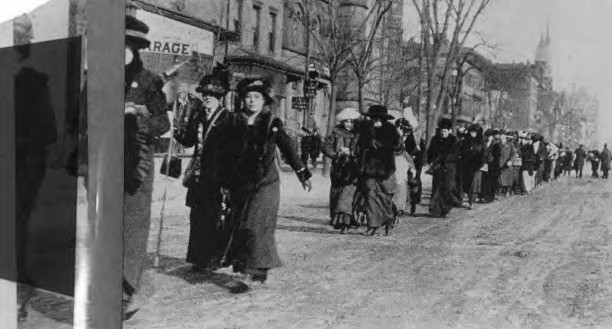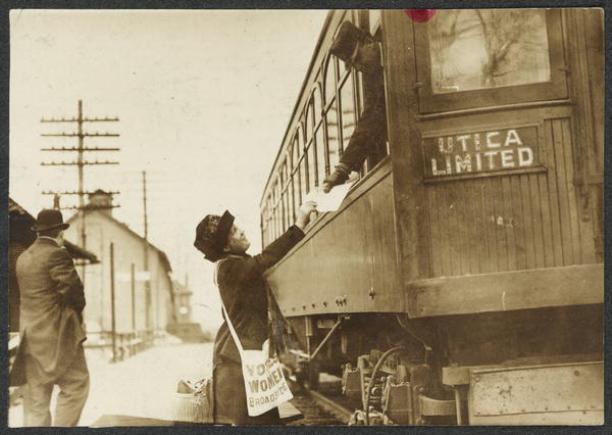By Steve Thornton
It was March 1912. Emily Pierson and her sister suffragists were on a statewide tour of Connecticut, putting up posters, distributing handbills, speaking wherever they could find a space. Pierson’s brigade made one last stop at a factory before reaching Hartford. Inspired by the activists, one young woman worker decided to make her own statement. As she walked across the factory floor she paused at a dirty window and with her finger wrote “Votes for Women” in the grime. A male superintendent soon discovered the slogan and angrily wiped it off.
The next morning, when the workers started their shift, they found every window had been thoroughly cleaned. For the first time in years. the sunlight shone through. “Well, if the mere mention of votes for women has that effect,” the young worker told the suffragists, “I wonder what the vote itself would do?”
The voting booth and the shop floor were two important arenas in the fight for women’s equality. Suffragists sought to change the US Constitution, while women trade unionists demanded parity in the state’s factories and garment shops. When these two movements intersected—in Hartford and around the country—both groups came closer to their common goal of women’s equality.

Josephine Bennett and daughters Frances and Katherine. Hartford, ca. 1916 – Connecticut Woman’s Suffrage Association, State Archives, Connecticut State Library
Emily Pierson and Josephine Bennett on the Front Lines
Josephine Bennett was the founder of the Hartford Equal Franchise League and a prominent advocate for women’s rights. With her husband Martin, she donated land in Katonah, New York, to create Brookwood Labor College, the country’s first residential workers’ school. The Bennetts were credited with being the training ground for influential organizers of the Congress of Industrial Organizations (CIO). “We teach the truth,” Josephine said, “and we train workers to work in their own movements.”
Hartford suffragists also challenged the shameful practice of child labor. Three million US children between the ages of 10 and 16 were wage earners in 1915. Disease and high injury rates were widespread in Connecticut mills; effective workplace safety laws and factory inspections were almost nonexistent. The Equal Franchise League educated its members on the harsh realities faced by young factory and mill workers. The group agitated for a federal ban on child labor, pensions for mothers, and education reform.
Local suffragists, who were largely middle and upper class, knew they had to win over working class women who would also benefit from the franchise. They consciously included working women in their activities. Hartford activists invited local sale girls and telephone operators to join their movement. “Only by having all women enfranchised on equal terms with men can the protection of women and girls be accomplished,” the League declared. Local activists were part of a national effort to lobby President Woodrow Wilson for his support of the 19th amendment. On May 2, 1914, when more than 1,000 suffragists paraded through the streets of Hartford, the line of march included large numbers of working women, identified by their occupations.
During an innovative “trolley campaign” through Hartford’s streets, Emily Pierson and others addressed a lunchtime crowd of 400 Underwood Typewriter employees in front of the factory. As one writer noted:
There is being born among women, particularly women in the more oppressive and poorly paid lines of labor, a feeling of solidarity, a feeling that what injures one hurts the cause of all, and that the only way the world can be forced to recognize their rights and grant them is by means of organized labor.
A Divide Between Progressive and Conservative Unions
Conservative trade unions clung to the notion that they could maintain their relatively privileged status by ignoring all workers except those who were white, skilled, and male. But progressive unionists like those found in the Industrial Workers of the World (IWW, or Wobblies) understood the need not only to organize women but to make sure they took their rightful place as leaders and organizers. For the first two decades of the 20th century, famed agitators Elizabeth Gurley Flynn and Connecticut’s Matilda Rabinowitz organized both male and female factory workers for the Wobblies throughout the state.

Women Protestors of the Day March for the Vote
– Hartford History Center, Hartford Public Library and the Treasures of Connecticut Libraries
Male trade unionists also took up the cause of women’s political rights. Machinists’ union organizer Sam Lavit of Bridgeport had “done more for the National Women’s Party in Connecticut than any other man” declared a leading suffragist. But maybe the most telling moment in the effort to build a coalition between the women’s and union movements came at the 1916 convention of the Connecticut State Federation of Labor. Although its national body was on record in support of women’s suffrage, local labor leaders balked when a suffrage resolution reached the Hartford gathering. Abbie O’Connell, a Willimantic textile worker, joined Emily Pierson on the convention floor to plead their case. The women’s vote resolution was opposed by union cigar makers and saloon keepers, who considered the effort a job-killer because they equated suffrage with prohibition (another movement also largely led by women). Ironically, the few union women who were voting delegates also opposed the resolution, arguing that suffrage was a political question, not an economic one. “When we were asking the legislature for better working hours for women did we get help from the suffragists,” asked one hostile delegate. “Yes, I spoke for the measure,” Emily Pierson retorted.
While the vote was being debated on this hot September day, brawny delegates cooled themselves with paper fans, inscribed with the words “Keep cool and raise a breeze for suffrage.” Despite parliamentary maneuvers to keep the resolution from being voted on, a heated discussion ensued. The motion passed, as did another to reduce hours of work for women.
Work for Equality Continues After Vote is Won
The struggle for women’s suffrage escalated. Josephine Bennett in particular could be found at union organizing meetings and on picket lines with garment workers, Underwood strikers, and many others. “It is a glorious thing to be called an agitator,” Bennett said after being criticized for her participation in these labor struggles. A visiting garment union organizer declared, “Comrades, one of the things that you need in Hartford is not so many city fathers but a few more city mothers, and I think you’d better take Mrs. Bennett as one of them.”
Two decades after she led her 1912 statewide suffrage tour, Emily Pierson was on the road again. This time, her cause was the 1935 strike of Colt Firearms workers. Now a physician and the health officer in a nearby town, Dr. Pierson walked the picket line and took home movies of the strikers. Explaining why she believed that support for the workers would increase as the public learned the truth, Pierson told a reporter, “It’s a case of the weak against the strong, don’t you know?”
Steve Thornton has been a labor union organizer for 35 years and writes on the history of working people.
This article originally appeared on ShoeLeatherHistoryProject.com









